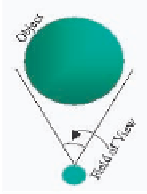Java Reference
In-Depth Information
Figure 10. Window eyepoint policy and field of view
public int getWindowEyepointPolicy
public void setWindowEyepointPolicy(int policy)
// Get and set policy on how to handle changes in the frustum if the window is moved. Options are:
// RELATIVE_TO_SCREEN - regard the window as an opening to a fixed virtual world
// thus, when the window is moved, a different view frustum has to be rendered
// RELATIVE_TO_WINDOW - assume that the physical eye position and the virtual world moves together
// with the window; there will be no change in the view frustum even as the window is shifted
// RELATIVE_TO_FIELD_OF_VIEW - the field of view can be changed in this default mode
// changing the field of view angle will change the view platform so as to give the specified field of view
// RELATIVE_TO_COEXISTENCE - take the eye position from the view object and transformed from
// coexistence coordinates to Canvas3D coordinates; the resulting eye position is relative to the screen
// and the view frustum changes when the window is moved.
public double getFieldOfView
public void setFieldOfView(double fieldOfView)
// Get and set field of view with a default of 45 degree, valid for RELATIVE_TO_FIELD_OF_VIEW
Results at different field of view
policy and the field of view. Figure 10 summarizes the possible options which are valid
and selectable in a non-head tracked environment.
Note that both the eyepoint policy and field of view are given by the horizontal field of
view and apex angle in the pyramid in the perspective projection in Figure 8. Under the
third option, which is the default, a horizontal field of view angle can be specified. The eye
position is then calculated to give the specific field of view needed. The maximum field of
view is π, which corresponds to the ability to see the entire horizon.
conventIonal camera-based vIeW
Java 3D provides methods for generating the transform groups needed to obtain views
by using essentially a camera on the virtual world. These are summarized in Figure 11,
and serve to provide compatibility and links to 3D graphic programs developed using the
traditional camera based viewing model (Sowizral, Rushforth, & Deering, 2000). Note,




Search WWH ::

Custom Search